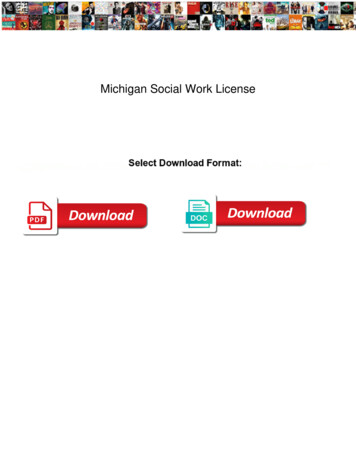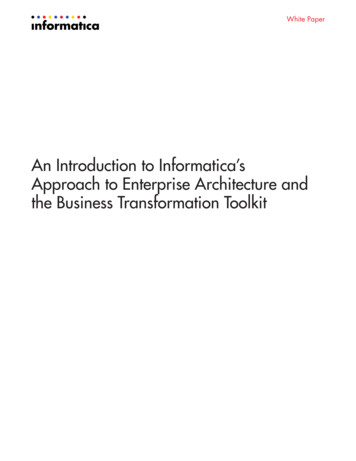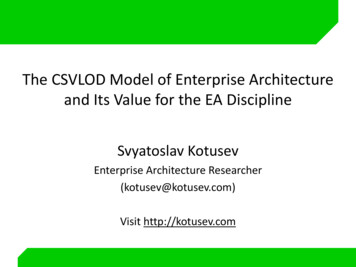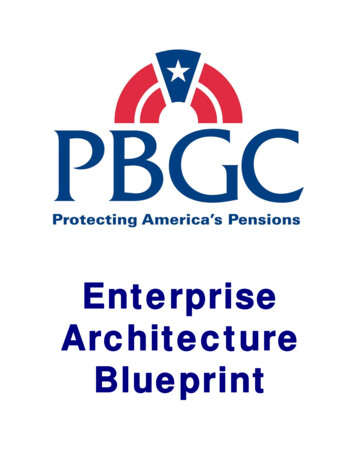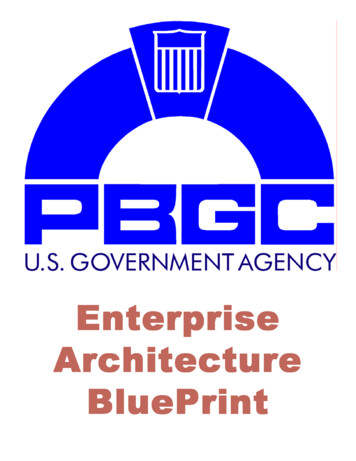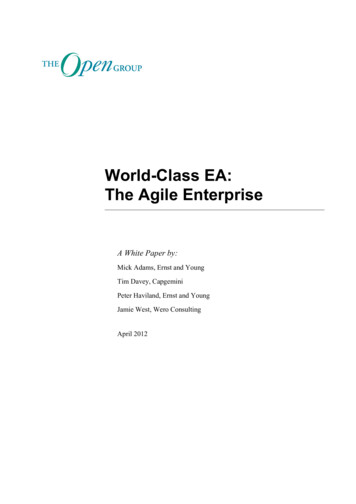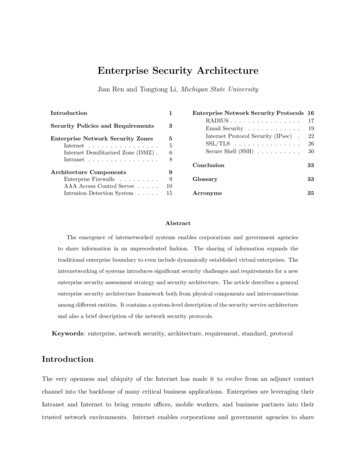
Transcription
Enterprise Security ArchitectureJian Ren and Tongtong Li, Michigan State UniversityIntroduction1Security Policies and Requirements3Enterprise Network Security ZonesInternet . . . . . . . . . . . . . . . .Internet Demilitarized Zone (DMZ) .Intranet . . . . . . . . . . . . . . . .5568Architecture ComponentsEnterprise Firewalls . . . . . . . . .AAA Access Control Server . . . . .Intrusion Detection System . . . . .991015Enterprise Network Security ProtocolsRADIUS . . . . . . . . . . . . . . . .Email Security . . . . . . . . . . . .Internet Protocol Security (IPsec) .SSL/TLS . . . . . . . . . . . . . . .Secure Shell (SSH) . . . . . . . . . actThe emergence of internetworked systems enables corporations and government agenciesto share information in an unprecedented fashion. The sharing of information expands thetraditional enterprise boundary to even include dynamically established virtual enterprises. Theinternetworking of systems introduces significant security challenges and requirements for a newenterprise security assessment strategy and security architecture. The article describes a generalenterprise security architecture framework both from physical components and interconnectionsamong different entities. It contains a system-level description of the security service architectureand also a brief description of the network security protocols.Keywords: enterprise, network security, architecture, requirement, standard, protocolIntroductionThe very openness and ubiquity of the Internet has made it to evolve from an adjunct contactchannel into the backbone of many critical business applications. Enterprises are leveraging theirIntranet and Internet to bring remote offices, mobile workers, and business partners into theirtrusted network environments. Internet enables corporations and government agencies to share
information in an unprecedented fashion. In fact, the Internet has made many enterprise businessesto completely redefine the way they deliver and manage approved corporate applications.While helping business to interact more effectively with customers, streamline operations, reduceoperational costs, and increase revenues, Internet needs to have a tremendous liability. However, asa global system of interconnected computer networks, the Internet was designed to share resources,not to protect. Allowing outside users into a trusted internal network also potentially opens thedoor to serious threats as legacy applications become network-enabled and as network managersopen their networks to more new users and applications.The security of commercial data has always been a primary concern and a vital enterpriserequirement. However, providing security services to commercial data is very challenging to accomplish, both for ensuring the safety and integrity of customer data and protecting the competitiveadvantage that comes with superior enterprise intelligence. In the past, enterprises only needed toprotect the flow of information within the business, today they must also consider the threat fromoutside of the corporate Intranet.Enterprise security architecture is becoming a critical component of the enterprise security solutions around the globe. The primary purpose of creating an enterprise security architecture isto ensure that business strategy and IT security are aligned. As such, enterprise security architecture allows traceability from the business strategy down to the underlying technology. Securityarchitecture provides the framework and foundation to deliver mission-critical services to its employees, partner and customers, enable secure communication, protect agency business processesand information resources, and ensure that new methods for delivering service are secure.Security risk management plays an important role in determining enterprise security solutionsand security services (Buecker et al. n.d.). Depending on the particular environment, communication security, emanations security, physical security, personnel security, and administrative security,other information security measures and safeguards are also incorporated in the enterprise securityarchitecture. An enterprise security architecture results from a series of trade-offs among cost,effectiveness, technical risk, mission requirements, and risk management. The framework for thefederal enterprise information process, management and sharing among federal agencies (Centersfor Medicare & Medicaid Services; Chief Information Officer Council 2001; U.S. Department ofHomeland Security n.d.) may provide some guidance for general enterprise security management
and architecture development.Security Policies and RequirementsThe enterprise security architecture starts from the enterprise security policy regarding securityrisks based on the enterprise context. The enterprise security policy sets the direction for thesecurity manager to identify the enterprise security requirements, security services and securitystandards, which takes the general goals and restates them in terms of specific technology areas.The security architecture is designed to enforce enterprise security requirements set forth by theenterprise. The security requirements should identify and define the enterprise physical perimetersand security domains or security zones. The security requirements need to be very specific about thenetwork domains and subsystems that should be protected in the network, what types of protectionmust be in place, and what types of application in your system must be specifically safeguardedagainst possible security attacks. The security requirements should also describe how applicationspecific sensitive information will be protected. All confidential and restricted access portionsof the application should be protected by appropriate access control. All critical-level applicationvulnerabilities should be protected against and verified through security testing, including commandinjection, SQL injection, cross-site scripting, and parameter manipulation.A representative network security architecture should have security requirements defined fromthe following areas (Red Book n.d.):Authentication and Access Control:In an enterprise network, authentication is the processof reliably verifying the identity of a person, or verifying the origin of data as authentic, or assuringthat a computer program is a trusted one.Authorization is the process of granting or denying access of a person, a process, or a machineto a network resource (Anderson 2008). Authentication and authorization are a two-step accesscontrol process. The first stage is authentication, which ensures that a principle (person, process,machine) is authentic. The second stage is authorization, which determines the resources that theprinciple is allowed to access.For authentication and network access control, many factors should be considered in deter-
mining the access control requirements. These factors include, for example, the identification andauthentication of hardware devices, device locations, operating systems, processes, network domains, network applications and users.Confidentiality:Confidentiality has been defined by the International Organization for Stan-dardization (ISO) as “ensuring that information is accessible only to those authorized to haveaccess (ISO 2004).” Confidentiality is one of the cornerstones of information security. It is madepossible in practice by the techniques of modern cryptography.Confidentiality services include both data confidentiality and traffic flow confidentiality. Dataconfidentiality is used to protect the transmitted data from disclosure to unauthorized persons sothat it is only accessible by the authorized parties. Traffic flow confidentiality is used to protectthe traffic pattern to prevent information disclosure based on statistical traffic analysis, includingthe source and destination, message length, frequency, and other characteristics of the traffic on acommunications facility (Stallings 2006).Communication Integrity: The goal of communication integrity is to maintain data consistency. More specifically, communication integrity service assures that the messages are receivedas sent, with no duplication, insertion, modification, reordering, or replays. Enterprises are moreconcerned with accuracy and data integrity against unauthorized modification than disclosure incertain cases as unauthorized modification can be caused by virus and malicious software.Non-Repudiation:Non-repudiation is a security service used to prevent either the sender orthe receiver from denying a transmitted message. Thus, when a message is sent, the receiver canprove that the alleged sender in fact sent the message. Similarly, when a message is received, thesender can prove that the alleged receiver in fact received the message. Non-repudiation is alsosometimes called third party authentication.Availability: The goal of availability is to ensure that information, systems, data, networks, andapplications can be used or reachable at any time needed by an authorized system entity. A varietyof attacks can result in the loss of or reduction in availability. An availability service is one thatprotects a system to ensure its availability. This service addresses the security concerns raised by
denial-of-service attacks. It depends on proper management and control of system resources andthus depends on access control and other security services (Stallings 2006).Many other issues, such as network management and selective routing, could also impact theenterprise security policy and requirements. The enterprise security should be enforced througha multilevel security strategy. This means that security protection should be defined at differentlayers, from physical layer to the application layer. Moreover, requirements should be enforcedacross the entire enterprise network, not just at the enterprise Internet firewall or the enterpriseaccess gateway to enforce enterprise security policy.Enterprise Network Security ZonesA successful enterprise security architecture is a functional combination of policies, technology,and leading practices so that they align with the organization’s core goals and strategic direction.Although often associated strictly with information security technology, implementation of thepolicy also determines the processes, standards, and products that are needed. The enterprisesecurity architecture also relates to the security practice of business optimization, performancemanagement, and risk management.A typical enterprise network architecture, as shown in Figure 64.1, contains three securityzones: Internet, demilitarized zone (DMZ) and Intranet. Each network zone has its own securitypolicy and access control requirements. The data transmission between different zones, therefore,has to pass through different security access control and data monitoring. The enterprise securityarchitecture should define the access control and security monitoring for data to be transmittedbetween different zones.InternetThe Internet is a global system of interconnected computer networks that interchange data bypacket switching using the standardized Internet Protocol Suite (TCP/IP) (Murhammer et al.1999). The Internet is a global network that consists of millions of private and public networkdevices linked by copper wires, fiber-optic cables, wireless connections, and other technologies.The Internet was designed as a shared resource. It carries various information resources and
IntranetCustomer support subnetCorporate data subnetExpert SystemWorkstationCustomer databaseDevelopment subnetAccountingInternal MailServerPCServerInternalDNS ServerAAA ServerInner Firewall(DMZ Firewall)DMZDNS ServerDMZ MailServerWeb ServerOuter Firewall(Perimeter Firewall)Routeror NASInternetFigure 64.1: Enterprise Network Physical Security Architectureservices, such as electronic mail, file transfer and file sharing, World Wide Web (WWW), onlinegaming, and online chat. Because the Internet is an uncontrolled zone, no enterprise componentsshould be placed in the Internet zone.
Internet Demilitarized Zone (DMZ)A demilitarized zone (DMZ) is a physical or logical subnetwork that contains and exposes anorganization’s external services to a larger, untrusted Internet. DMZ is a portion of a network thatseparates a purely internal network from an external network. It provides a “buffer” between theuncontrolled Internet and the internal networks. The DMZ is typically bounded by two firewallsto add an additional layer of security protection to an organization’s network while enabling theexternal users to access certain enterprise resources, such as web page, domain name server (DNS)and customer support, and so on.The network architecture has the functionality that the public entities may enter the corporateperimeter established through the perimeter firewall (outer firewall), but are confined to the DMZarea separated by the DMZ firewall (inner firewall). The goals of the outer firewall are to restrictpublic access to the enterprise network, such as the access to the Web server and mail server, andto restrict the internal user’s access to the Internet. The perimeter firewall therefore presents aninterface that allows connections to the WWW services and to electronic mail. The system in theDMZ serves as mediators, with the firewalls providing the guards.As a restricted zone, the incoming/outgoing traffic may be filtered as appropriate through theperimeter firewall. The access control policy for the DMZ is generally less restrictive than theIntranet. When information moves from the Internet to the internal network, confidentiality isgenerally not an issue. However, integrity is always an issue. The guards or the firewalls betweenthe Internet and the DMZ, and between the DMZ and the internal network, must not acceptmessages that will cause servers to work incorrectly or to crash. When information moves fromthe internal network to the Internet, both confidentiality and integrity have to be considered. Thefirewalls must ensure that no confidential information goes to the Internet and that the informationthat reaches the Internet is correct. An external users will only be given permission to access someof the resources in the DMZ, however, the secure subnet, or intranet is still secure.In a network, the hosts most vulnerable to attack are those that provide services to usersoutside of the local area network (LAN), such as mail server, web server and DNS server. Due tothe increased potential of these hosts being compromised, they are placed into their own subnetworkin order to protect the rest of the network if an intruder was to succeed. Hosts in the DMZ should
not be able to establish communication directly with any other host in the internal network, thoughcommunication with other hosts in the DMZ and to the external network is allowed. This allowshosts in the DMZ to provide services to both the internal and external network, while an interveningfirewall controls the traffic between the DMZ servers and the internal network clients.In principle, the internal IP address can be any unused IP address. However, to conceal theaddress of the internal network, a common practice is to assign each host a private IP address(Murhammer et al. 1999; Rekhter et al. 1996). Private IP address is a special class of IP addresses.Private IP Addresses cannot be used to connect directly to the Internet since the Internet routersare generally configured to discard any packets containing private IP addresses in the IP header.Using private IP addresses creates a basic form of isolation and security of the private networksas it is usually impossible for the outside world to establish a connection directly to a machineusing these IP addresses. In addition, since connections cannot be made between two differentprivate networks via the Internet, different organizations can use the same private addresses withoutrisking IP address conflicts. Therefore, while concealing the IP address, the application of privateIP address also helps dealing with the IP address shortage problem since the private addresses canbe reused by all enterprises.For enterprise employed with a proxy-based firewall, when an electronic mail connection isinitiated using the simple mail transfer protocol (SMTP), the SMTP proxy on the proxy-basedfirewall collects the mail. It then analyzes it for computer viruses and other forms of maliciouslogic before it forwards the mail to the DMZ mail server. The mail server in the DMZ performsaddress and content checking on all electronic mail message. The goal is to hide internal informationfrom the outside while being transparent to the inside.When a web request arrives, the firewall scans the request for any suspicious components beforeit forwards it to the DMZ web server. The DMZ web server does not contact any servers or information sources within the internal network. This means that even if the web server is compromised,the compromise will not affect the internal network.The Domain Name System (DNS) is a standard technology for managing the names of Web sitesand other Internet domains. The DMZ DNS server contains directory name service informationabout the network devices. The DNS server does not contain the addresses of the internal mailserver.
IntranetLike the Internet DMZ, an enterprise intranet is a security controlled zone that contains componentswith which clients may directly communicate. The DMZ firewall separates the DMZ from theintranet of the enterprise private network. The security access control of the intranet is muchmore restrictive than the DMZ. All traffic to the enterprise private network needs to go throughthe DMZ, and never goes directly from the Internet. For security purposes, the DMZ firewall isgenerally configured to block all traffic, except for a limited set of traffic permitted upon a successfulauthentication and access control verification.Within the Intranet, one or more security restricted network zones may be designated to furtherenforce secure access control so that access is only granted to a small group of authorized staff. Inaddition, each security restricted network zone may have different access control policy, therefore,access into one area does not necessarily grant access to another secured area.Architecture ComponentsThis section describes the function of the network components listed in Figure 64.1. Dependingupon the particular network architecture, some of these network components may be combined intoa single solution.Enterprise FirewallsA firewall is a device or a set of devices that mediates access to and from a network (Stallings2006; Bellovin and Cheswick 1994), allowing and disallowing certain types of access on the basis ofa configured security policy. Firewall software often runs on a dedicated server placed between thetwo networks, with one network being specially protected.Most enterprises employe proxy firewalls. A proxy firewall adds to a filtering firewall the abilityto base access control on content, either at the packet level or at a higher level of application. It canhave access control that is based on the content of packets and messages, as well as on attributesof the packet headers, such as destination addresses and source addresses. Therefore, they canprovide better security. However, they do so at the cost of performance.Proxy firewalls are also known as application firewalls. They operate on the Application Layer
of the Open System Interconnection (OSI) model (Stallings 2006; Bellovin and Cheswick 1994).In a proxy firewall, a proxy is an intermediate agent or server that acts on behalf of an endpointwithout allowing a direct connection between the two endpoints. A proxy firewall uses a proxy toperform access control on the flow of information through a firewall.When the user contacts the network using a TCP/IP application, such as Telnet or FTP, thepacket is stopped at the firewall, the packet is then examined and compared to the rules configuredinto the firewall and asks the user for the name of the remote host to be accessed. After theuser responds and provides a valid user ID and authentication information, the proxy forwardsthe received information to the enterprise authentication server, which is generally a dedicatedauthentication, authorization, and accounting (AAA) server, such as RSA SecureID AAA server(RSA n.d.) or Secure Computing SafeWord AAA server (Secure Computing n.d.), to performaccess control. If the packet passes the AAA authentication, it is re-created and sent out. Becauseeach packet is destroyed and re-created, there is a potential that an application-proxy firewall canprevent unknown attacks based upon weaknesses in the TCP/IP protocol suite that would not beprevented by a packet filtering firewall.The drawback is that a separate application-proxy must be written for each application typebeing proxied. You need an HTTP proxy for web traffic, an FTP proxy for file transfers, etc. Inaddition, like all other firewalls, the proxy firewall cannot protect against attacks performed withina security zone, such as internal threats and the transfer of virus-infected programs or files.AAA Access Control ServerAn AAA server (de Laat et al. 2000) is a critical network security component that providesauthentication, authorization, and accounting (AAA) services for secure enterprise network access.In other words, it is capable of authenticating users, handling authorization requests, and collectingaccounting data. For an enterprise, such an AAA server interfaces to an application specific modulethat manages the resource for which authorization is required. The AAA server typically interactswith network access gateway servers, databases and directories containing user information. TheAAA is sometimes combined with auditing and accordingly becomes AAAA server.AAA server provides a framework for intelligently controlling access to computer resources,enforcing policies, auditing usage, and providing the information necessary to bill for services.
These combined processes are considered important for effective enterprise network managementand security.The AAA service is often provided through a dedicated AAA server. The current major standardby which the network devices or applications communicate with an AAA server is the RemoteAuthentication Dial-In User Service (RADIUS) (Rigney et al. 2000; Rigney 2000). A RADIUSclient is an essential component for a RADIUS based AAA authentication. RADIUS can be usedto enforce enterprise-wide consistent entity authentication on top of the IP link authentication.AuthenticationAuthentication (Stallings 2006) refers to the process of reliably identifying a user, typically byhaving the user enter a valid user name and the corresponding password before access permissionis granted.Authentication is accomplished based on each identity having a unique set of credentials forgaining access. The AAA server compares a user’s authentication credentials with other usercredentials stored in a database. If the credentials match, the user is granted access to the network.If the credentials are at variance, authentication fails and network access is denied. Examples oftypes of credentials are passwords, one-time tokens, digital certificates, and biometrics readings.An authentication server is a dedicated network device, such as an AAA server, that performsauthentication services for users, network systems and network traffic entering a protected network.To ensure that all incoming traffic is authenticated before it is allowed to go through the enterpriseaccess perimeter, the typical industry solution is implemented through a centralized authenticationand access control server. The authentication server is normally integrated with the enterpriseproxy firewall so that the authentication and access control services can be forwarded to a dedicatedauthentication server. In this way, access control policy can be consistent and applied to all trafficthroughout the enterprise network.Authentication is used as the basis for authorization (determining whether a privilege will begranted to a particular user or process), privacy (keeping information from becoming known tonon-participants), and non-repudiation (not being able to deny having done something that wasauthorized to be done based on the authentication).
Bob(Verifier)Alice(claimant)AliceAlicenh n ( pwd )nx h n 1 ( pwd )h( x )CompareyesAlicen 1 h n 1 ( pwd )Figure 64.2: Lamport’S Hash-Based One-Time PasswordAuthentication Standards:There are multiple standards that can provide entity authentica-tion. These standards include:Password-Based Authentication:Password-based authentication is the simplest and old-est method of entity authentication, where the password is something that the claimant (Alice)knows. A password is used when a user needs to access a system to use the system’s resources.Password-based authentication schemes include fixed password and the one-time password. A fixedpassword is a password that is used repeatedly for each access. Some of the major problems withfixed password-based authentication are eavesdropping, stealing of password and password guessing.One-Time Password:A one-time password is a password authentication system that eachpassword is only used once. One-time password can effectively prevent password eavesdroppingsince the eavesdropped password cannot be reused. Therefore, one-time password can also preventreplay attack.Leslie Lamport invented an interesting one-time password scheme (Lamport 1981) withoutusing public-key cryptography. This scheme allows the verifier (Bob) to authenticate the user in away that neither eavesdropping on an authentication exchange nor reading the verifier’s databaseenables someone to impersonate the user (Alice). The user and the system agree upon an originalpassword, pwd, and a counter, n. The system calculate hn (pwd), where hn (pwd) means applying a
hash function h (Stallings 2006) on pwd n times repetitively. In other words,hn (pwd) h(hn 1 (pwd)).The system stores the identity of the user, the value of n and the value of hn (pwd). Figure 64.2shows how the user accesses the system the first time.Challenge-Response Authentication:In password authentication, Alice proves her iden-tity to Bob by demonstrating that she knows the secret password directly. However, because Alicereveals this secret, it is susceptible to interception by the adversary. In challenge-response authentication, Alice proves that she knows a secret without sending it. In other words, Alice does notsend the secret password to the verifier Bob; the verifier either has it or can easily access it.The challenge is a varying value, such as a random number or a time-varying value that issent by the verifier, as shown in Figure 64.3. Alice (claimant) applies a function to the challengeand sends the result back to the verifier as a response. The response shows that Alice knows thesecret. In the random number scenario, the verifier often sends a nonce, which is a one-time randomnumber that can be used only once. The application of nonce can effectively prevent replay attacksand dictionary attacks. In the time-varying scenario, Alice usually sends the date and/or time atwhich a certain event occurred in a consistent format, called timestamp. Timestamp is used toprove that the request existed at a certain time to prevent replay attack.Cryptographic algorithms, such as keyed-hash functions and asymmetric-key cipher, can also beused to provide cryptographic-based authentication. In general, cryptographic-based authenticationcan be much more secure than the password-based authentication. The basic idea is that theidentification verification is based on a cryptographic operation performed on a secret.AuthorizationFollowing authentication, a user must gain authorization for doing certain tasks. Authorizationrefers to the granting of specific types of privileges to an entity or a user, based on their authentication. It is the verification that someone is really allowed to do what he is requesting to do. Thisis usually checked after user authentication by verifying access control lists (ACLs) (Vollbrecht et
(a) Nonce challengeBob(Verifier)Alice(claimant)Alice, Timestamp(b) Timestamp challengeFigure 64.3: Challenge-Response Authenticational. 2000b; Vollbrecht 2000a; Farrell et al. 2000). The ACLs may contain, for example, time-of-dayrestrictions, or physical location restrictions, or restrictions against multiple logins by the sameuser.Authorization is also the process of enforcing policies: determining what types or qualitiesof activities, resources, or services a user is permitted. Usually, authorization occurs within thecontext of authentication. Once you have authenticated a user, they may be authorized for differenttypes of access or activity.Most of the time the granting of a privilege constitutes the ability to use a certain type ofservice. Examples of types of service include, but are not limited to: IP address filtering, addressassignment, route assignment, QoS/differential services, bandwidth control/traffic management,compulsory tunneling to a specific endpoint, and encryption.AccountingThe final plank in the AAA framework is accounting, which measures the network resources a userconsumes during access. This can include the amount of system time or the amount of data a user
has sent and/or received during a session. Accounting is carried out by logging of session statisticsand usage information and is used for authorization control, billing, trend analysis, resource utilization, and capacity planning activities. These information may be used for management, planning,billing, or other purposes.Real-time accounting refers to accounting
enterprise security assessment strategy and security architecture. The article describes a general enterprise security architecture framework both from physical components and interconnections among di erent entities. It contains a system-level description of the security service architecture



